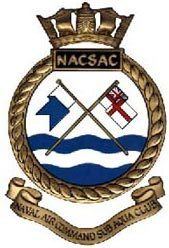 | ||
The Naval Air Command Sub Aqua Club (NACSAC) is an organisation within the Royal Navy that oversees sports and technical diving training activities for naval aviation and fleet units. Today it has branches at RNAS Culdrose (HMS Seahawk) and RNAS Yeovilton (HMS Heron). Both bases provide training, and club members regularly dive in their local areas on weekends. Diving instruction, from beginner to advanced level, is offered under the auspices of the British Sub Aqua Club.
In the early 1960s a group of Chief Petty Officers from the Naval Air Command decided to form amateur diving clubs and mounted annual expeditions. These clubs were first based at the naval air stations of Portland (HMS Osprey), Culdrose and Yeovilton and conducted diving under the auspices of an umbrella organisation which became known as the "Naval Air Command Sub Aqua Club" (NACSAC). The club's first chairman was Lieutenant Roy Graham (1924–2007), an engineer officer who had begun his diving career aboard the aircraft carrier HMS Victorious. Whilst in Gibraltar, he was in charge of diving training on this ship. Following a shallow water diving course with 24 entrants and only himself and a Royal Air Force medical officer finishing the rigorous training, Graham became the only Fleet Air Arm officer with a naval diving qualification. One of the club's first projects was to send a team of divers to the Isles of Scilly to find an historic Royal Navy ship, like HMS Association, a 90-gun ship of the line lost in the great naval disaster in 1707. In 1964 about ten NACSAC members - including the shipwreck expert and writer, Chief Petty Officer Richard Larn - arrived on Scilly, believed to be only the second group of divers to visit the area. Their initial dives began a series of navy visits that continued for four years. In 1964, 1965 and 1966 the divers could only access the Western Rocks, but barely around the Gilstone Ledge, where a later expedition managed to locate the wreck of HMS Association in 1967. The rediscovery of the site also led to more government legislation, notably the Protection of Wrecks Act 1973, passed in an attempt to preserve British historic wreck sites as part of the maritime heritage.
The annual expeditions, organised to promote diving as an exciting sport, have become a key focus of NACSAC activities. Despite changes to the Royal Navy Fleet command structure, the club has retained its historic title and continues to advocate sports diving activities.
